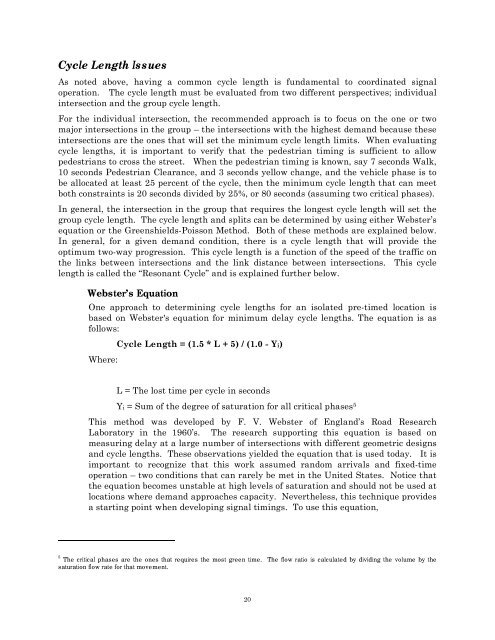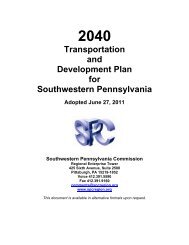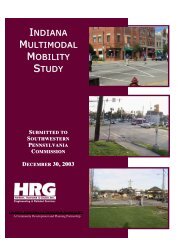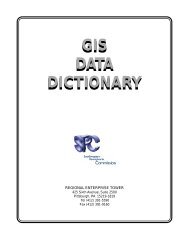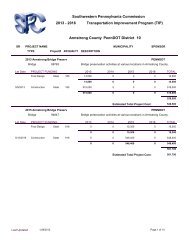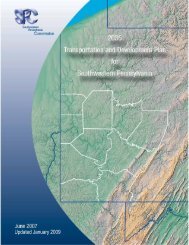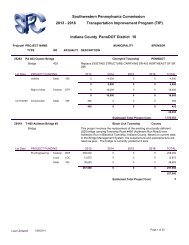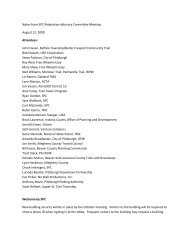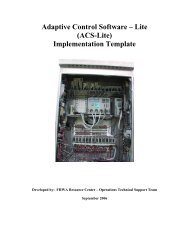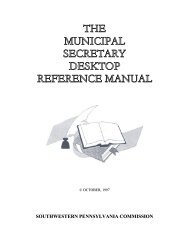FHA Signal Timing On A Shoestring
FHA Signal Timing On A Shoestring
FHA Signal Timing On A Shoestring
You also want an ePaper? Increase the reach of your titles
YUMPU automatically turns print PDFs into web optimized ePapers that Google loves.
Cycle Length Issues<br />
As noted above, having a common cycle length is fundamental to coordinated signal<br />
operation. The cycle length must be evaluated from two different perspectives; individual<br />
intersection and the group cycle length.<br />
For the individual intersection, the recommended approach is to focus on the one or two<br />
major intersections in the group – the intersections with the highest demand because these<br />
intersections are the ones that will set the minimum cycle length limits. When evaluating<br />
cycle lengths, it is important to verify that the pedestrian timing is sufficient to allow<br />
pedestrians to cross the street. When the pedestrian timing is known, say 7 seconds Walk,<br />
10 seconds Pedestrian Clearance, and 3 seconds yellow change, and the vehicle phase is to<br />
be allocated at least 25 percent of the cycle, then the minimum cycle length that can meet<br />
both constraints is 20 seconds divided by 25%, or 80 seconds (assuming two critical phases).<br />
In general, the intersection in the group that requires the longest cycle length will set the<br />
group cycle length. The cycle length and splits can be determined by using either Webster’s<br />
equation or the Greenshields-Poisson Method. Both of these methods are explained below.<br />
In general, for a given demand condition, there is a cycle length that will provide the<br />
optimum two-way progression. This cycle length is a function of the speed of the traffic on<br />
the links between intersections and the link distance between intersections. This cycle<br />
length is called the “Resonant Cycle” and is explained further below.<br />
Webster’s Equation<br />
<strong>On</strong>e approach to determining cycle lengths for an isolated pre-timed location is<br />
based on Webster's equation for minimum delay cycle lengths. The equation is as<br />
follows:<br />
Where:<br />
Cycle Length = (1.5 * L + 5) / (1.0 - Yi)<br />
L = The lost time per cycle in seconds<br />
Yi = Sum of the degree of saturation for all critical phases 5<br />
This method was developed by F. V. Webster of England’s Road Research<br />
Laboratory in the 1960’s. The research supporting this equation is based on<br />
measuring delay at a large number of intersections with different geometric designs<br />
and cycle lengths. These observations yielded the equation that is used today. It is<br />
important to recognize that this work assumed random arrivals and fixed-time<br />
operation – two conditions that can rarely be met in the United States. Notice that<br />
the equation becomes unstable at high levels of saturation and should not be used at<br />
locations where demand approaches capacity. Nevertheless, this technique provides<br />
a starting point when developing signal timings. To use this equation,<br />
5<br />
The critical phases are the ones that requires the most green time. The flow ratio is calculated by dividing the volume by the<br />
saturation flow rate for that movement.<br />
20


